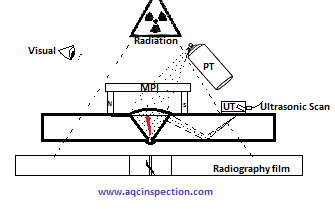The Significance of Thorough Welding Evaluation in Industrial Applications
In the world of commercial applications, the significance of precise welding assessment can not be overstated. As we explore the diverse advantages of attentive welding evaluations, one should take into consideration the more comprehensive ramifications on security, dependability, and cost-effectiveness in commercial procedures.
Enhancing Structural Honesty
When it comes to welding examination in commercial applications, boosting structural stability is critical. The primary objective of welding assessment is to make certain that the welds are qualified of birthing the expected tensions and loads they will encounter in solution.
The value of preserving architectural honesty in welded structures can not be overstated. Improperly implemented welds can lead to disastrous failures, causing pricey fixings, downtime, and also endangerment of human lives. Consequently, assessors play a crucial duty in the lifecycle of commercial elements, offering guarantee that the welding process provides the wanted stamina and toughness.
In addition, advanced innovations, such as phased variety ultrasonic testing and digital radiography, offer boosted capacities in finding prospective weaknesses, enabling for rehabilitative steps before problems rise. By focusing on the honesty of welds via meticulous examination, industries can make sure functional effectiveness and extend the durability of their infrastructure.
Recognizing Welding Problems
Determining welding flaws is an important facet of guaranteeing the safety and integrity of welded structures. These issues can jeopardize the stability of the whole assembly and, if left unaddressed, may lead to disastrous failures. Typical welding issues include porosity, cracks, incomplete combination, and damaging. Each of these defects emerges from certain causes, such as incorrect welding methods, contamination, or insufficient warmth control.

Skilled assessors make use of both visual examination and advanced non-destructive testing (NDT) techniques, such as ultrasonic or radiographic testing, to spot these problems. The timely recognition and rectification of welding problems are critical to maintain the architectural integrity and long life of industrial components.
Guaranteeing Compliance Specifications
Compliance with recognized standards, such as those supplied by the American Welding Culture (AWS) and the International Organization for Standardization (ISO), ensures that welds satisfy minimum safety and top quality needs. These requirements include a wide array of criteria, including material specs, welding procedures, and qualification of welders.
Normal audits and inspections are crucial in confirming compliance. Inspectors need to possess a thorough understanding of the pertinent standards and be adept at utilizing various non-destructive screening (NDT) techniques to evaluate weld high quality. By making sure that welding techniques line up with compliance criteria, business mitigate the danger of non-conformity, which can lead to legal obligations and safety risks.
In addition, maintaining compliance not only safeguards structural stability yet additionally improves a company's track record in the industry. Stakeholders and clients are extra most Discover More likely to trust fund companies that consistently demonstrate a dedication to quality and safety useful source and security with extensive conformity. Thus, making sure conformity requirements is an essential component in the successful application of welding in commercial applications.
Lowering Maintenance Expenses

The application of innovative non-destructive testing (NDT) techniques, consisting of ultrasonic, radiographic, and magnetic particle inspections, boosts the capability to discover subsurface problems without jeopardizing the architectural honesty of components. By utilizing these strategies, industries can significantly prolong the service life of their equipment, lowering downtime and the linked monetary worry of upkeep activities.
Moreover, a robust welding examination regime supports the optimization of upkeep timetables, shifting from reactive to predictive maintenance techniques. This proactive approach not just cuts unanticipated failures but likewise enhances source appropriation, guaranteeing that upkeep initiatives are concentrated and reliable. Inevitably, the investment in rigorous welding assessment is offset by the substantial savings recognized through lowered maintenance demands, adding favorably to the general operational effectiveness of industrial business.
Improving Safety And Security Procedures
Welding assessment plays a critical duty in this context, as it makes certain that all connections and joints satisfy rigid safety standards. Comprehensive inspections assist recognize problems such as fractures, porosity, or incomplete fusion that might compromise structural integrity.
Methods like ultrasonic testing, radiographic screening, and magnetic bit inspection allow for thorough exam without harming the framework. Implementing a robust quality control system that consists of normal training for assessors and welders makes certain adherence to developed security requirements.
Last but not least, cultivating a society of safety within the company highlights the importance of comprehensive welding evaluations. Motivating open communication and partnership amongst assessors, welders, and engineers adds to a shared dedication to security quality. Welding Inspection Madison. In doing so, markets can guard their procedures, secure workers, and preserve public trust

Verdict
Detailed welding evaluation is essential in industrial applications, significantly boosting architectural stability and reliability. By using sophisticated non-destructive screening methods, potential welding issues moved here such as fractures and incomplete blend are determined early, guaranteeing conformity with market standards and cultivating client count on. Rigorous examinations result in decreased upkeep prices and add to a safer working atmosphere. Eventually, the persistent implementation of welding assessments plays a crucial duty in preserving operational performance and security in industrial setups.
As we explore the diverse advantages of persistent welding examinations, one need to consider the wider effects on safety, dependability, and cost-effectiveness in commercial operations.
The main objective of welding examination is to guarantee that the welds are qualified of birthing the anticipated stresses and loads they will run into in service. Effective welding assessment plays an integral function in minimizing these costs by making sure the integrity and longevity of welds, thereby alleviating the threat of premature failures.Complete welding examination is crucial in commercial applications, significantly enhancing architectural honesty and integrity. Eventually, the thorough execution of welding evaluations plays an important function in maintaining functional performance and safety and security in commercial settings.